Nintendo 3DS Review
Nintendo 3DS
With glasses-free 3D, powerful specifications, improved controls and a host of extras in an attractive and portable package, is Nintendo's latest portable games console worth getting?
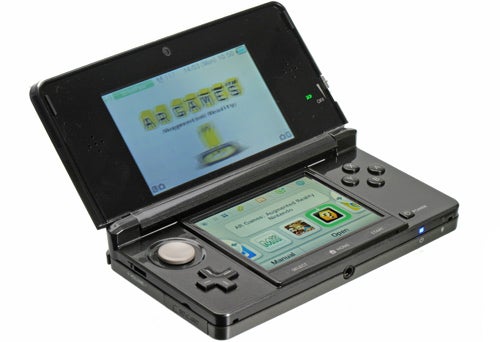
Verdict
Pros
- Fun
- Glasses-free 3D works
- Superb controls
- Mini-games included
- Well-built
Cons
- Poor battery life
- Proprietary charger
- Region-locked games
Key Specifications
- Review Price: £187.99
- 3.5in glasses-free 3D display
- 3in secondary touch display
- Wi-Fi G, 2GB storage
- ?3D? camera
- Wireless multiplayer gaming
Ever since the original DS, Nintendo has been using innovation to sell its consoles. With the DS it was a touch screen, while with the Wii it was motion control. Now the ‘next big thing’ is 3D. It’s in everything from our TVs (like the Samsung D7000) to our laptops (such as the impressive HP Envy 17 3D). However, one of the most frequent complaints about these methods for giving you that extra dimension are the glasses you have to wear to get the effect. So Nintendo has utilized a glasses-free 3D display to give its new portable console’s graphics extra depth without the eyewear, and called it the 3DS.
The question that’s bound to be on many people’s minds is whether the 3DS is just a souped-up DS with a gimmicky 3D screen. Does the real deal live up to our largely positive impressions from our 3DS hands-on in January? Read on to find out.
First off, let’s talk about the design. The basics of Nintendo’s successful clamshell design haven’t changed too much since the days of the original GameBoy Advance SP. With the original DS it gained in width to accommodate widescreen displays, with the DS Lite Nintendo slimmed things down and gave its portable those sleek lines that have helped it sell like hot cakes ever since. The evolutionary DSi didn’t mess with a successful formula and neither, essentially, does the 3DS.
Mind you, that’s very much a good thing; clamshells work for a reason. Most importantly, they protect the 3DS’ screens from dirt and scratches, meaning that a case is not required as it is for the Sony PSP. Another major advantage is that you can angle the main display to be comfortable for viewing while leaving the bottom half of the 3DS at an ergonomic angle for the controls. On the PSP you have to go for one or the other.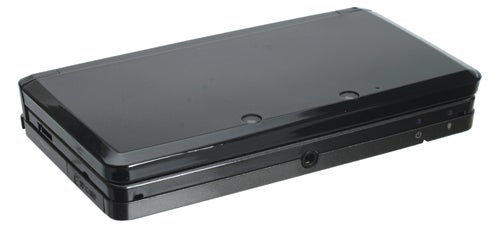
Despite the extra processing power in the 3DS, it’s virtually the same size as the DS and DSi. In fact, when they’re closed these consoles can be a little hard to tell apart, with the main differentiator being the 3DS’ twin cameras instead of a single one on the DSi and none on the DS.
As usual for Nintendo, build quality is very solid. The 3DS feels like it can take most of the abuse many people subject portable consoles to without breaking; the plastics are strong and thick, while the hinge offers smooth action.
Unfortunately, Nintendo has decided to go back to glossy for the 3DS. After switching to a matt finish with the DSi, we were hoping this would be a permanent change. Shiny might look better and the finish Nintendo has used is more resilient than most, but after only a few hours your console will be covered in unsightly fingerprints that need to be wiped off if you want to keep it looking good. Call us boring, but we find a matt finish just looks more… mature.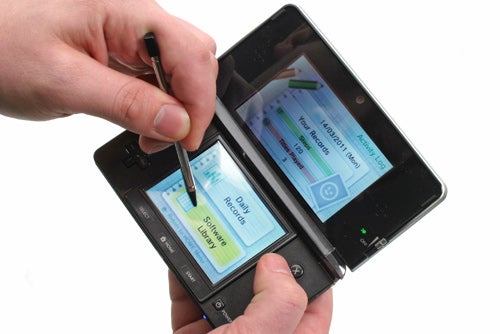
Another thing we’re not sure about is Nintendo’s choice to use a gradation in the colour of its new portable. Whether you go for the Cosmos Black or Aqua Blue version, the top half fades to a slightly lighter colour on the bottom half. It makes the console look like it consists of two disparate bits stuck together, and we far prefer the unified shade of the older DS generation.
Mind you, as far as colour choices go, both black and aqua are very attractive, and we wouldn’t be surprised if pink and white joined the party later in the 3DS’ life-cycle. Indeed, on its own merits, the 3DS is quite a good-looking console.
When it comes to connectivity, there’s not much that’s new here over the DSi. On the left you get a volume slider and a flap covering an SD card slot. Like everything else on the 3DS, the flap’s rubber hinges feel solid and durable. A 2GB SD card is included by default, and though it’s a tad stingy it’s nice to have one included by default, enough to store pictures, game saves and other data. It accepts SDHC cards so you can add up to 32GB, which should be more than enough to keep even the most content-hungry gamer happy.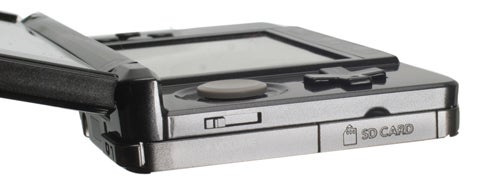
Along with charge and power LEDs, the headphone jack is still located at the front, which isn’t as convenient as at the side but in keeping with previous DS models. On the right there’s a wireless switch and you can also access the 3D slider here, though we can’t really see the use of this being accessible with the console closed.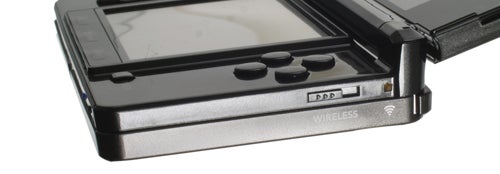
The included stylus is now found around the back, a location that’s not quite as convenient as on the DS Lite and DSi where it was found on the left side. There’s a spring-loaded cartridge slot which will take DS games as well as the new, slightly wider 3DS cartridges. Just remember that DS titles will be in good old 2D, as there’s no conversion on hand. As with the DSi, GBA cartridges are no longer on the menu, so if you have a large GBA collection it’s worth hanging on to your DS Lite. 
Here you’ll also find the charging port, and we’re very disappointed to find that it’s proprietary. Again. This might have been just about acceptable in the days of the older DS generations, but now we live in the age of universal chargers, where most devices on the market have Mini or Micro USB charging ports. It’s really annoying to find Nintendo forcing you to use its proprietary adapter and, even worse, the socket is different to that found on older DS models so you can’t even use your old chargers. At least the two meter cable on the AC adapter is long enough for most situations.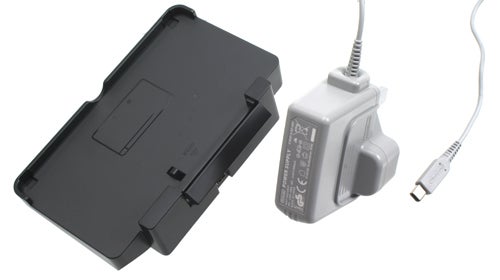
We’re rather more enthusiastic about the supplied charging dock, which is included by default rather than an optional accessory you have to pay extra for. You can plug the charger into the console directly or into the dock. If you go for the latter option, simply drop the 3DS into the dock and it will charge, as well as putting the console at an angle that’s comfortable for viewing material on its top screen. Finished in a combination of glossy and matt black plastic, it’s well-built and attractive.
Opening the console up, we still have two screens, with the top one supporting glasses-free 3D while the smaller bottom screen uses resistive technology to offer interaction through touch or using the included stylus. The touch screen is as responsive as ever, with even light touches being registered accurately. The stylus is a telescopic metal affair that’s heavier and slightly longer than its DSi predecessor, and though it’s not quite as comfortable it’s still perfectly usable. 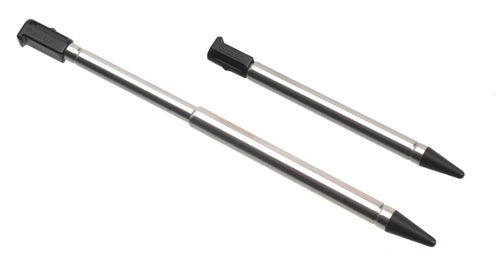
The main addition to the rather dated controls on older DS models is an analogue stick, which Nintendo calls the Circle Pad. This really is one of the 3DS’ greatest strengths. It’s vastly superior to the rather poor equivalent on the Sony PSP, offering a comfortable concave shape, slightly soft finish and perfect, springy action. It’s almost as good as the regular sticks on a joypad, and perhaps its best recommendation is that it works really well in high-precision fighting games as well as for racers, platformers and what have you.
To be honest, it pretty much makes the D-pad below it redundant, though this can be used for different functions. With all the practise Nintendo has had, it’s not surprising that the D-pad is also as good as ever, and the left and right shoulder triggers now offer far better feedback than ever before, making them a pleasure to use.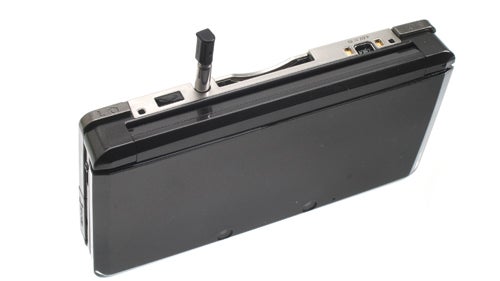
To the right of the touch screen we have the same four Y, X, A, and B buttons as before. Feedback is just a bit more shallow than on its predecessors, but you wouldn’t notice without comparing them side by side. We would really have liked to have seen a second analogue stick below these for first person shooters, and this is one advantage that Sony’s NGP or PSP2 will undoubtedly make the most of. Fast, precision first person shooters is a whole genre Nintendo has effectively handicapped itself in.
The Start and Select buttons now join a new Home button below the touchscreen. Though they have the appearance of touch sensitive controls, they’re actually normal buttons though they’re almost flush with their surround. To be honest, Nintendo has taken a step backwards with this implementation, as on the original DS models you could easily press these without needing to look. On the 3DS they’re poorly differentiated and it’s far too easy to press the wrong one by mistake. 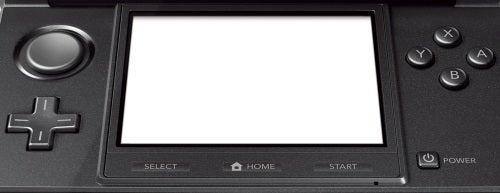
We’re also not overly fond of the power button and prefer the older side-mounted switch. However, pressing this button doesn’t just switch the console off anymore. Rather, it brings up the choice to power down or enter Sleep Mode, which will bring back all your applications the way they were when you power it up next. Just remember that unlike Microsoft Windows’ Hibernate mode, Sleep Mode will continue draining your battery – albeit at a far reduced rate.
Overall, we like the new console’s controls. Despite a few devolutions, the Circle Pad and sharper triggers make the games we tried on the 3DS a joy to control, so we reckon Nintendo’s latest portable is definitely a positive step.
Built into the 3DS’ top half to either side of the screen, its stereo speakers are quite impressive. They pump out more volume than their size would suggest, and while clarity isn’t anything to boast about, they throw in a modicum of bass too. They’re perfectly usable for games and even movies, though for the latter we would still strongly suggest headphones.
As already mentioned, the 3DS’ 3in bottom screen allows for the same resistive interaction as before, but its resolution is upped from 256 x 192 to a far healthier 320 x 240, making menus, text and graphics look sharper than ever before. Viewing angles are adequate, and – surprisingly – slightly stronger on the vertical than horizontal plane. It’s no AMOLED display like on the Samsung Galaxy S or IPS-based iPhone 4 Retina display, but it’s good enough for its purpose.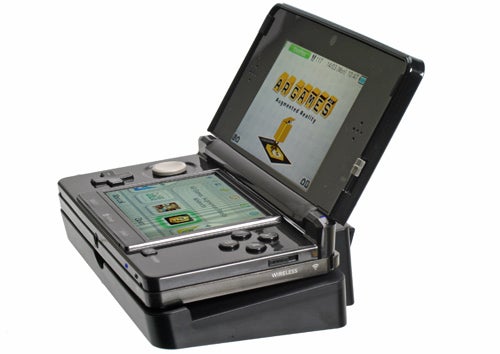
The top screen is really where the magic happens. It’s 3.5 inches and sports an impressive 800 x 240 resolution, though in 3D you only get 400 x 240. This is a necessary sacrifice to achieve that third dimension. The screen achieves the illusion of depth without glasses (called autostereoscopy) by essentially feeding your eyes two images separated by a parallax barrier (a series of carefully calibrated slits) so that, from the right angle, each eye sees only the image intended for it.
Does it work? In a word, yes! Of course it’s not flawless. Go too far off-angle and the illusion disappears, leaving you seeing a double image. However, the workable angles are surprisingly generous, and as long as you’re not trying to view the display with more than one person, you shouldn’t have too much trouble maintaining 3D. 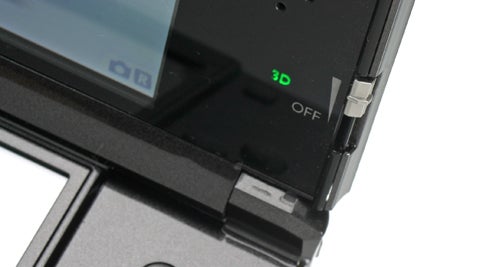
It is a little more tiring on the eyes than plain old 2D, but we would definitely argue that – obviously depending on the software or game – the extra immersion makes this more than worthwhile. And the best news is that if you would rather do without for a while, that’s perfectly possible. To the right of the screen is a 3D depth slider, with which you can adjust the perceived depth to your liking or even (shock, horror) turn the 3D-effect off altogether. This really is a great feature, as it gives you the choice of how you want to view your content.
It’s a good thing, then, that the top screen holds up fairly well in 2D mode. Viewing angles are superior to the bottom one, though still far from perfect. Aside from this it’s sharp, punchy and bright with relatively deep blacks, helped by a glossy finish that does cause annoying reflections when playing particularly dark titles in a bright environment. Again, we would have preferred a matt finish, but it wasn’t to be. 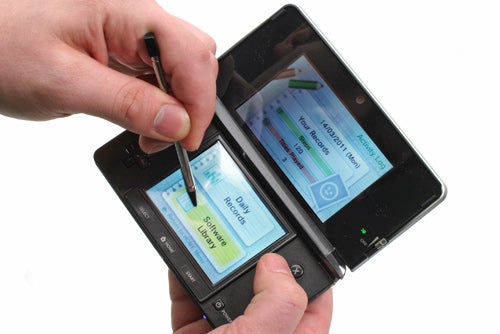
One other annoyance is that, when playing previous generation DS titles, there are significant black bars around the top image. It essentially becomes 3in rather than 3.5in, and we can’t help but wish Nintendo had found some way of harnessing the 3DS’ extra processing power to upscale the top image to match the screen’s dimensions.
We can only speculate as to the hardware inside the 3DS as Nintendo hasn’t revealed anything officially. What with the dual-core 1GHz phones and Nvidia Tegra 2 graphics provided by the likes of the LG Optimus 3D (incidentally another glasses-free 3D device, along with the newly-announced HTC Evo 3D), the 3DS’ sub-300MHz ARM11 CPU and 133MHz, single-core GPU don’t sound all that impressive. However, along with the console’s 64MB of RAM, it’s enough power to drive some seriously good-looking games. On the best launch titles, quality would appear to be somewhat better than the level of the original Xbox – an impressive feat considering this is a mobile console and that it needs to render each frame twice to output 3D. 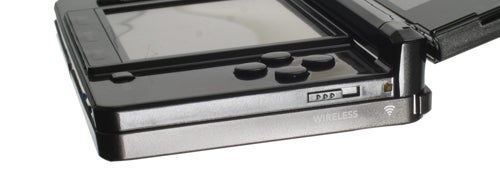
Wi-Fi G is on hand for networking, while a motion sensor and gyroscope add… scope for more interactions in games and movement controls in applications.
Altogether the 3DS has three cameras: one facing in, and two on the lid. Thus you can’t take 3D self-portraits or video-chat in 3D, but you can take 3D pictures which you can then view in all of their glorious dimensionality on the autostereoscopic top screen. Unfortunately, all three of the cameras are, quite frankly, rubbish. They sport a lowly 640 x 480 (0.3 megapixel) resolution and offer poor low light performance, and the results are predictably grainy, washed out and lacking in detail.
Nintendo was obviously limited by attempting to maintain a sub-£200 price point, but it’s a real shame that the cameras are simply a compromise too far. On the other hand, for integrating real elements into certain games and basic augmented reality titles they are (barely) adequate.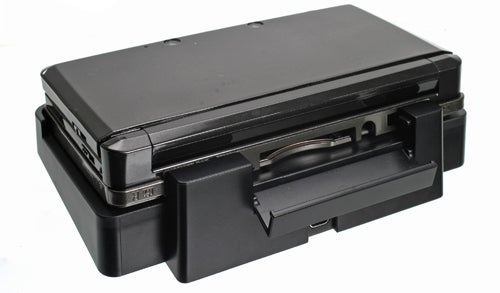
With a console offering so many functions, options and interaction methods, the interface was never going to be as simple as on the original DS. However, Nintendo has done a sterling job of creating an interface that’s both intuitive and attractive, in a kid-focused, bright and fluffy kind of way.
Each of the functions and applications are represented by a logical icon on the lower screen, which you can choose to arrange in a line or grid. The top screen shows an intricately animated and fully 3D representation of your selected item, so you never lose the wow-effect (if you find 3D wow-worthy in the first place, of course).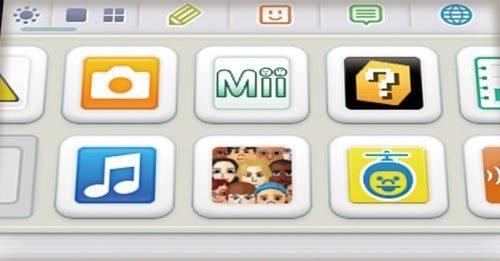
Another thing that’s well-handled is multi-tasking, though its scope is very limited. If you’re in one application or game and want to head back to the main menu, the application is suspended but stays visible as a transparent background. Unfortunately, in most cases you’ll have to exit the old application before the console lets you launch a new one.
Wii owners will be familiar with the Miis, personalised avatars that represent you in certain games and when interacting with other 3DS owners.
StreetPass lets your 3DS communicate with other people who are carrying one in your vicinity, allowing you to exchange information and play mini-games with or against each other. This is a feature with a lot of potential: finding new people to play with and potentially making new friends, it’s like social networking with a physical proximity radius.
SpotPass automatically detects and uses wireless access points to automatically synchronise and update. A functional web-browser has been promised in a future firmware update.
In a nice and clever touch, Nintendo has finally included games with one of its consoles out of the box, and they do a good job of showing off some of what makes the 3DS unique.
Face Raiders, which is just as disturbing as it sounds, takes a picture of your face (and those of loved ones, friends or colleagues) and plasters it onto a malignant floating 3D head, which you then have to shoot against the background of your actual environment (which is captured in real time by the twin rear cameras). You move your view not by using the controls but by moving the whole console, which tracks your movements very accurately using its built-in motion sensor and gyroscope. If you’ve ever seen Eliminate: GunRange on the iPhone 4 you’ll know exactly how this plays, except here the action gets really frantic and there’s a double dose of augmented reality in ‘real’ 3D.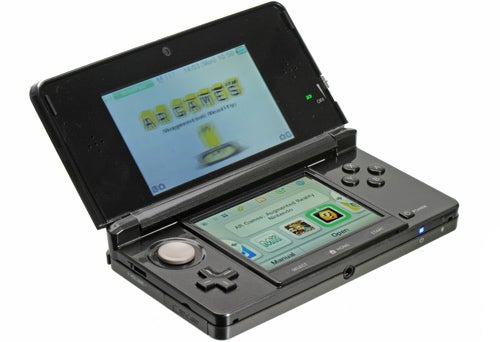
The other title is AR Games, where AR stands for Augmented Reality. With your 3DS you’ll get a cardboard package containing six cards. Five of these contain 3D models of some iconic Nintendo characters like Mario, Zelda and Samus. However, one merely has a question mark on it. Put this card on a surface, wait for the 3DS to ‘read’ it and it will overlay a virtual world onto this surface. Creatures and stages will pop out of this physical card to make for some of the most entertaining augmented reality mini-games we’ve ever played. We’re really looking forward to what future cards might do.
We’re also cautiously excited about Nintendo’s launch lineup of full-blown titles. Highlights include Street Fighter IV 3D, Nintendogs + Cats, Pilot Wings Resort, Ridge Racer 3D, Super Monkey Ball 3D, Pro Evo Soccer 2011 3D, The Sims 3 and more. Unfortunately, none of them are original properties, but at worst they add an extra dimension to familiar titles, and at best they’re impressive showcases of just how far mobile gaming has come.
We’re very sorry to hear that 3DS games will be region-locked, where before Nintendo handhelds always let you buy your games anywhere in the world. This is a major step back, though it won’t affect a large portion of consumers. 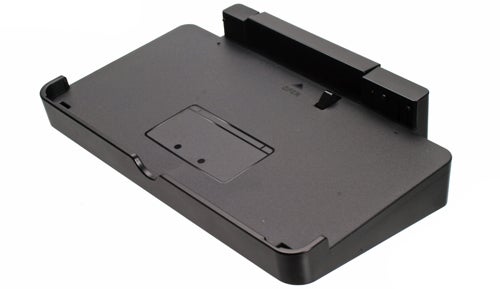
Unfortunately, our biggest complaint with the 3DS has nothing to do with its 3D, connectivity or usability, but with its battery life – or rather lack thereof. On the DS Lite you could happily game all day, and then game some more; over 10 hours at a very usable screen brightness was easy to achieve. With the 3DS, you’ll be lucky to get half that, and that’s with the brightness turned down and Wi-Fi turned off.
Of course, this is more than enough for many, but Nintendo’s console is like modern smartphones in that you will need to remember to charge it every day if you intend to use it with everything turned on. Turning off 3D will also increase battery life, but then of course you’re missing out on one of the console’s main attractions. It’s worth noting that third party manufacturers are already offering extended battery packs.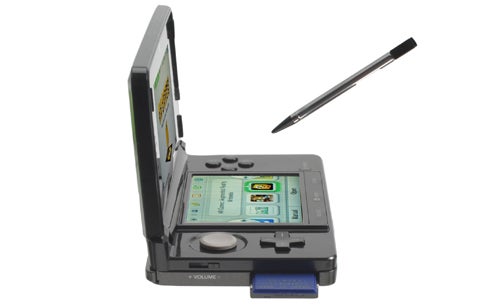
When it comes to value the 3DS is a very reasonable proposition. Though there’s no MSRP in Europe since Nintendo is letting retailers set their own prices, at the moment £188 seems to be about the cheapest it is available at. Considering the DSi debuted at £150 and did far less to justify its cost, the 3DS could be considered a bit of a bargain.
Verdict
It’s not without its faults and won’t be for everyone, but overall Nintendo’s 3DS does it once again: it’s a well-built and eminently usable console that offers unique appeal, stuffed with fun features and potential. The glasses-free 3D really works, and if you get tired of it you can simply use it in 2D, where you still get the most powerful dedicated portable gaming machine around. Considering its small premium over previous generation DS systems, it’s definitely worth considering if you don’t mind its short battery life.
Trusted Score
Score in detail
-
Value 8
-
Features 9
-
Design 7

